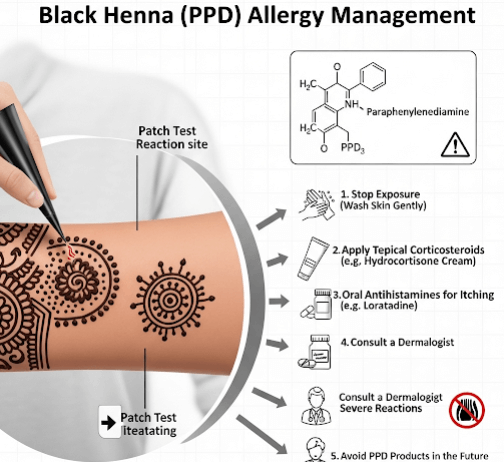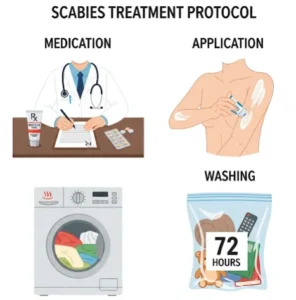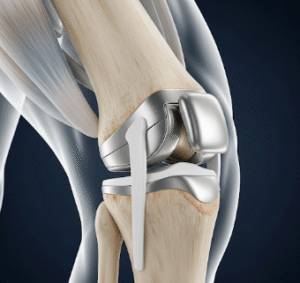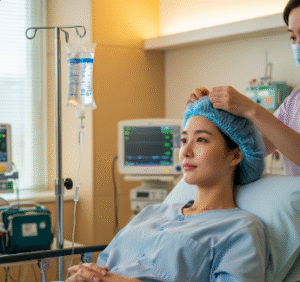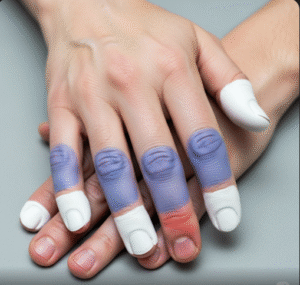Specialized care for skin reactions caused by para-phenylenediamine exposure
What it is
Black henna is a temporary body art or hair dye that is often mixed with para-phenylenediamine (PPD) to achieve a darker, longer-lasting stain. Natural henna produces a reddish-brown tint, but the addition of PPD makes the dye black and more intense.
The problem is that PPD is a strong allergen. When applied to the skin in high concentrations, it can cause severe allergic reactions. Symptoms may appear within hours or days and include:
- Redness, itching, and swelling at the tattoo or dyed area
- Blistering or oozing wounds that resemble burns
- Scabbing and crusting during the healing phase
- Persistent pigmentation changes or scarring
- Delayed hypersensitivity reactions, appearing months or even years later
Black henna allergy management focuses on controlling inflammation, repairing damaged skin, preventing complications, and ensuring future avoidance of PPD. In Korea, treatment combines allergy testing, medical dermatology, and cosmetic aftercare to achieve safe and aesthetic results.
Why it’s done
Managing black henna (PPD) allergy is necessary for several reasons:
✔ Symptom relief – Pain, itching, and discomfort can significantly affect daily life.
✔ Preventing skin damage – Without treatment, allergic reactions may cause permanent scars, thickened skin, or pigment changes.
✔ Reducing complications – Blisters and erosions may become infected if left untreated.
✔ Clear diagnosis – Confirming a PPD allergy prevents repeated reactions from hair dyes, textiles, or cosmetics that also contain the chemical.
✔ Psychological reassurance – Skin reactions can resemble infections or burns; proper treatment helps restore confidence.
Alternatives
Alternatives exist for both avoiding PPD exposure and managing allergic reactions.
→ Natural henna – Made from Lawsonia inermis leaves, it is reddish-brown and rarely causes allergies.
→ PPD-free hair dyes – Available in Korea with plant-based or safer chemical formulations.
→ Temporary tattoo stickers or organic inks – Safer cosmetic alternatives to black henna.
→ Camouflage makeup – Useful for covering pigmentation or scars after allergic reactions.
For treatment:
- Topical corticosteroids and antihistamines are common alternatives to systemic drugs.
- Phototherapy or cosmetic dermatology can be used to repair post-inflammatory pigmentation.
Preparation
Preparation begins with a careful medical evaluation.
➤ Dermatologic assessment – The affected skin is examined to determine the severity of the reaction.
➤ Allergy testing – Patch testing confirms sensitivity to PPD and checks for cross-reactions with similar chemicals.
➤ Medical history review – Patients with asthma, eczema, or prior allergies may be at greater risk of severe reactions.
➤ Treatment planning – Doctors explain whether topical therapy, systemic medication, laser treatment, or surgical excision is appropriate.
➤ Patient education – Families are advised about avoiding PPD in hair dyes, textiles, and leather products.
How it’s done
Treatment is tailored to the reaction’s severity.
➔ Acute management:
- Topical corticosteroids reduce redness and swelling.
- Oral antihistamines relieve itching.
- Cool compresses soothe burning sensations.
➔ Severe reactions:
- Short courses of oral corticosteroids control inflammation.
- Antibiotics are prescribed if infection develops.
➔ Skin repair phase:
- Healing creams, emollients, and barrier ointments are applied.
- In Korea, dermatologists often add LED light therapy, regenerative serums, or laser toning to enhance healing and minimize scarring.
➔ Long-term care:
- Patients are permanently advised to avoid all products with PPD.
- A safe alternatives list is provided for hair and skin products.
Recovery
Recovery time depends on severity.
→ Mild cases improve within 1–2 weeks with topical care.
→ Moderate to severe cases may take 2–4 weeks, especially if blisters or erosions are present.
→ Pigmentation changes may last several months but can be treated with Korean dermatologic methods such as pigment lasers or brightening treatments.
→ Scarring is rare with early care but may be treated later using fractional laser or microneedling.
→ Patients must remain cautious, since repeat PPD exposure usually causes stronger reactions.
Complications
Possible complications of PPD allergy include:
✔ Skin infection from blistered or open wounds
✔ Long-lasting pigmentation changes (darker or lighter skin patches)
✔ Scarring or keloid formation, especially after severe reactions
✔ Chronic dermatitis from repeated exposures
✔ Cross-reactivity with other chemicals, leading to allergies with hair dyes or textile products
In Korean clinics, complications are minimized by combining medical treatment with advanced skin repair therapies.
Treatment options in Korea
Korea is a leader in allergic skin condition management, including PPD allergy.
➤ Specialized allergy dermatology clinics – Located in Seoul, Busan, and Incheon, offering patch testing, medical treatment, and cosmetic repair.
➤ Laser and regenerative treatments – Clinics use fractional lasers, pigment lasers, and LED therapy to restore natural skin tone after allergic reactions.
➤ Scar prevention programs – Patients receive silicone gels, regenerative ointments, and scar-care regimens immediately after recovery.
➤ Integrated cosmetic dermatology – Healing is paired with aesthetic treatments to ensure natural, scar-free results.
➤ Patient education services – Clinics teach patients how to recognize hidden sources of PPD and select safe alternatives.
➤ International care systems – Korean hospitals provide bilingual consultations, structured treatment schedules, and follow-up care for medical tourists.
➤ Research and innovation – Korea contributes to global dermatology by publishing studies on contact dermatitis, ensuring PPD allergy care remains evidence-based and cutting-edge.
By seeking black henna (PPD) allergy management in Korea, patients gain access to world-class dermatology expertise, advanced technology, and aesthetic-focused care, making it one of the safest and most effective destinations for treatment.

